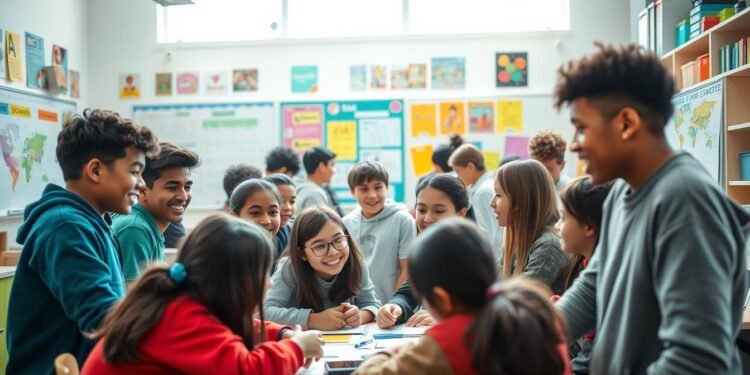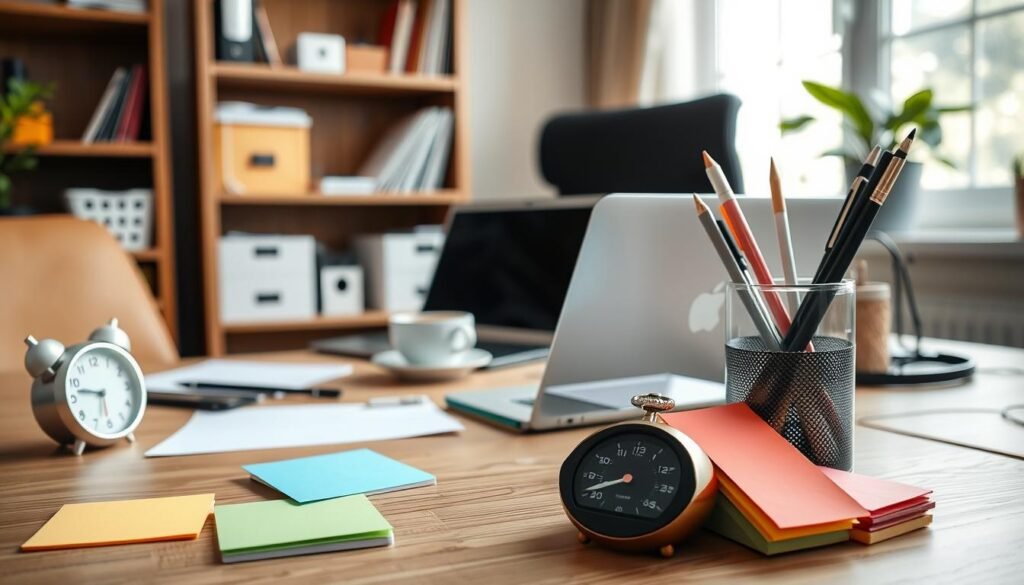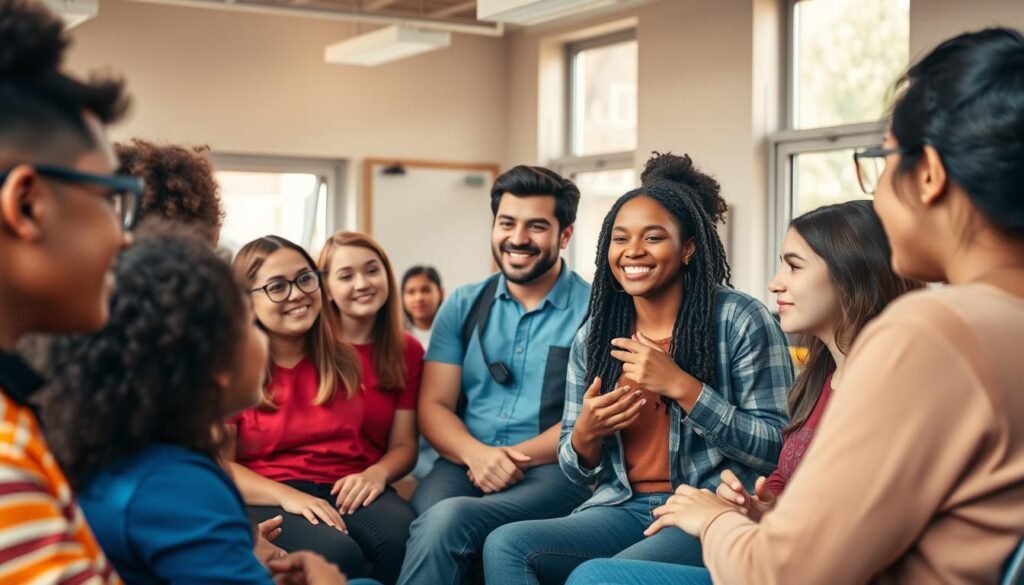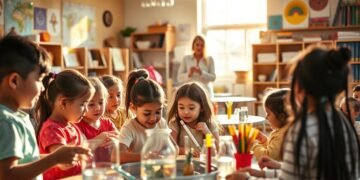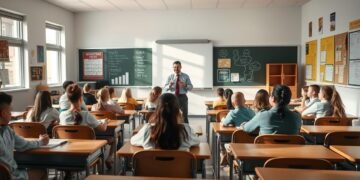Are you struggling to keep your class focused in today’s fast-paced world? With attention spans shrinking, traditional teaching methods often fall short. Research shows that learners need engagement shifts every 3-6 minutes to stay focused. How can you adapt to these modern challenges?
This article dives into actionable strategies that address these issues. From teacher-driven techniques to gamified learning, we’ll explore methods backed by research. Tools like Reading Eggs, with over 3,500 e-books, help connect lessons to real-world applications. Similarly, Meritopia in Mathletics uses gamification to boost motivation.
Building rapport and understanding behavioral, cognitive, and emotional dimensions are also key. Let’s uncover how you can create a dynamic and effective learning environment.
Key Takeaways
- Attention spans require engagement shifts every 3-6 minutes.
- Teacher-driven strategies are more effective than props.
- Reading Eggs offers 3,500+ resources for real-world connections.
- Gamification, like Meritopia, enhances motivation.
- Rapport-building improves academic performance.
1. Connect Learning to the Real World
Making lessons relevant to everyday life can transform the classroom experience. Studies show that 68% of learners perform better when they see practical applications of what they’re taught. By tying lessons to real-world scenarios, educators can make the learning process more meaningful and engaging.
Use Real-Life Examples and Case Studies
One effective way to connect lessons to the real world is through case studies. For instance, economics lessons can include examples from local businesses. This approach helps learners understand how theories apply in practice. Similarly, history classes can draw parallels between past events and current social issues, making the content more relatable.
Answer the Question: “When Will I Use This?”
Learners often wonder how their lessons apply outside the classroom. Addressing this question directly can boost motivation. Tools like Mathletics’ Live feature, which connects math to global competitions, show how skills are used in real-time. Career-focused segments in lesson plans also help learners see the value of their education.
By integrating practical examples and answering the answer question, educators can create a more dynamic and effective learning environment. These strategies not only improve performance but also foster a deeper understanding of the subject matter.
2. Engage with Students’ Interests
What if lessons could spark excitement by tapping into personal passions? Research shows that learners retain 40% more when their interests are woven into the curriculum. By connecting lessons to hobbies and passions, educators can ignite curiosity and make learning more meaningful.
Incorporate Hobbies and Passions into Lessons
One way to engage students is by integrating their hobbies into assignments. For example, TikTok-style videos can bring literature analysis to life. Fantasy sports leagues teach data analytics in a fun, relatable way. Even Minecraft EDU can turn geometry lessons into interactive adventures.
Trending YouTube videos can also enhance physics demonstrations, making complex concepts easier to grasp. These activities not only boost participation but also help learners see the real-world applications of their skills.
Build Rapport Through Shared Interests
Building rapport is another powerful strategy. Hosting “Expert Fridays” lets learners teach their peers about their hobbies. Music lyric analysis can make poetry units more engaging. When educators show genuine interest in what students take pride in, it fosters a supportive and collaborative classroom environment.
By aligning lessons with personal interests, educators can create a dynamic space where learning feels less like a chore and more like an adventure. This approach not only improves retention but also nurtures a lifelong love for learning.
3. Fill “Dead Time” with Quick Activities
Short, purposeful activities can turn downtime into valuable learning opportunities. Transition periods or lulls in the schedule don’t have to be wasted. Instead, they can be moments to refocus and reinforce key concepts.
Use Think-Pair-Share or Quickwrite Exercises
Think-Pair-Share is a simple yet effective way to spark discussion and critical thinking. Learners reflect on a question, share their thoughts with a partner, and then discuss as a group. This method keeps everyone involved and builds communication skills.
Quickwrite exercises are another great tool. These short writing tasks reduce off-task behavior by 41%. They allow learners to process information quickly and stay focused on the topic at hand.
Keep Students Focused During Transitions
Transitions can be challenging, but they’re also opportunities for creativity. For example, vocabulary charades make moving between activities fun and educational. QR code scavenger hunts add an element of excitement while reinforcing learning objectives.
Structured breaks, like Mathletics’ Meritopia, provide a 3-minute reset. These activities help refresh the brain and improve attention for the next task. Silent Ball tosses with curriculum questions are another engaging way to keep learners on track.
By filling “dead time” with meaningful tasks, educators can maximize every moment in the classroom. These strategies not only maintain focus but also enhance the overall learning experience.
4. Leverage Group Work and Collaboration
Collaborative efforts in the classroom can unlock new levels of participation and understanding. Research shows that structured group activities increase involvement by 57%. Peer teaching also boosts retention rates by 39%. These methods not only enhance learning but also help students build essential teamwork skills.
Encourage Peer-to-Peer Learning
One effective strategy is the “Jigsaw” method. Learners are divided into expert groups, each focusing on a specific topic. They then share their knowledge with others, fostering a deeper understanding of the material. This approach encourages active participation and accountability.
Virtual breakout rooms can also be used for debate preparation. Assigning roles like recorder, timekeeper, and presenter ensures everyone contributes. Shared Google Docs create transparency and keep the group on track.
Structure Groups for Maximum Engagement
Pairing learners with complementary skills can lead to better outcomes. For example, one might excel in research while another shines in presentation. Rotating roles within the group keeps the dynamic fresh and engaging.
Developing rubrics with input from the class adds fairness to evaluations. Clear criteria help learners understand expectations and focus on their tasks. These strategies make group work more effective and enjoyable for everyone involved.
5. Encourage Regular Presentations and Sharing
Incorporating frequent sharing sessions boosts confidence and participation. Studies show that weekly presentations increase confidence by 62%. This approach not only enhances communication skills but also deepens understanding of the material.
Make Presentations a Routine Part of Class
Regular presentations help students develop critical thinking and public speaking skills. Start with low-pressure formats like “Ignite Talks,” where learners present 20 slides in 15 seconds each. This keeps the process fast-paced and engaging.
Tools like Flipgrid allow for asynchronous video responses, making it easier for everyone to participate. Podcast-style group interviews or Pecha Kucha challenges can also make complex topics more accessible.
Reduce Pressure with Group or Seated Presentations
Group presentations can ease anxiety by distributing responsibility. Seated presentations reduce pressure by 45%, making them ideal for nervous learners. Hosting quarterly “TED-Ed Club” style events adds excitement and variety.
Live polling during presentations provides instant feedback, encouraging active discussion. These strategies ensure that every student feels comfortable sharing their ideas and answers.
6. Give Students a Voice in the Classroom
Empowering learners to take charge of their education can transform the classroom dynamic. When they have a say in their learning, motivation and outcomes improve significantly. Research shows that choice-based assessments increase completion rates by 51%. By fostering ownership, educators can create a more inclusive and effective learning environment.
Offer Choices in Activities and Assessments
Providing options in assignments and assessments allows learners to take control of their education. For example, a “Learning Menu” offers varied tasks, letting them choose what aligns with their strengths. Ranked-choice voting for class novel selections also gives them a say in the curriculum.
Student-designed rubrics are another powerful tool. They improve self-assessment skills and ensure fairness in evaluations. By offering multiple digital portfolio formats, educators cater to diverse learning styles and preferences.
Foster Ownership Over the Learning Process
When learners co-create classroom rules and consequences, they feel more invested in the school environment. Passion project quarters with public showcases let them explore topics they care about. This approach not only builds confidence but also connects learning to the world beyond the classroom.
Student-led parent-teacher conferences are another way to foster ownership. They take responsibility for presenting their progress, which enhances communication skills. These strategies ensure that learners are active participants in their education, not just passive recipients of instruction.
7. Use Mixed Media to Enhance Engagement
Integrating multimedia into lessons can revolutionize the learning experience. Research shows that multimedia lessons improve recall by 38%. By blending videos, audio, and digital resources, educators can create a dynamic and interactive classroom environment.
Incorporate Videos, Audio, and Digital Resources
Using tools like Nearpod with VR components can make lessons immersive. For example, history classes can explore ancient civilizations through virtual tours. Canva can be used for infographic assignments, helping learners visualize complex data.
Quizlet Live competitions add a fun, competitive edge to review sessions. Geo-tagged history lessons using Google Earth bring the past to life. These activities not only enhance understanding but also make learning more enjoyable.
Connect with Students’ Digital World
Producing student-run classroom podcasts allows learners to express their creativity. Adobe Spark can be integrated for visual storytelling, making projects more engaging. Mathseeds’ gamification increases math fluency by 42%, showing how digital tools can boost skills.
By aligning teaching methods with the digital world learners thrive in, educators can create a more relatable and effective classroom experience. These strategies ensure that lessons resonate with modern learners.
8. Get Students Moving During Lessons
Movement in the classroom can transform how lessons are absorbed and retained. Research shows that kinesthetic learners retain 72% more information when physical activities are integrated into lessons. Short bursts of movement, like 5-minute activity breaks, can improve focus duration by 33%. These strategies not only keep energy levels high but also make learning more dynamic and effective.
Use Physical Activities to Break Up Lessons
Incorporating movement into lessons can make a significant difference. For example, creating human graphs for math concepts turns abstract ideas into tangible experiences. “Walk and Talk” discussion circles encourage movement while fostering critical thinking. Escape room challenges with physical clues add excitement and teamwork to the learning process.
Yoga poses can be used for vocabulary retention, making memorization more interactive. Subject-specific dance routines bring creativity into the classroom. Mapping the classroom for geographical simulations turns lessons into immersive adventures. These activities ensure that learners stay engaged and focused.
Channel Energy into Productive Learning
Physical tasks can redirect energy into productive learning. For instance, yoga poses help learners focus while improving vocabulary retention. Dance routines tied to subjects like history or science make lessons memorable. Geographical simulations using the classroom space turn abstract concepts into hands-on experiences.
By incorporating movement, educators can create a more dynamic and effective learning environment. These strategies not only improve attention but also make lessons more enjoyable and impactful.
9. Scaffold Tasks with Checkpoints
Breaking down complex tasks into smaller steps can make learning more manageable. Research shows that chunked assignments improve quality by 28%. By dividing large projects into smaller, actionable parts, learners can focus better and achieve consistent progress.
Break Large Tasks into Manageable Steps
One effective method is the “I Do/We Do/You Do” gradual release model. This approach guides learners through tasks step by step, building their confidence and skills. Progress tracker dashboards also help visualize milestones, keeping everyone on track.
Coding-style debugging sessions can be used for error analysis. This encourages critical thinking and problem-solving. Celebrating milestones, like completing a project phase, adds motivation and a sense of accomplishment.
Use Checkpoints to Maintain Focus
Checkpoint systems reduce task abandonment by 64%. Peer check-in partners provide accountability and support. Visual roadmaps with sticker rewards make the learning process more engaging and transparent.
By scaffolding tasks and using checkpoints, educators can help learners manage their time effectively. These strategies ensure steady progress and reduce overwhelm, leading to better outcomes.
10. Conclusion: Building a Culture of Engagement
Creating a vibrant learning environment requires intentional effort and thoughtful planning. Schools that prioritize a culture of active participation see 89% higher attendance and 57% improved college readiness. These outcomes highlight the importance of fostering a sense of belonging and involvement in the classroom.
Practical strategies can make a significant difference. Weekly “Engagement Inventories” help track participation and identify areas for improvement. Staff-student committees ensure everyone has a voice in shaping the learning experience. Cross-curricular benchmarks and metrics in progress reports provide clear goals and accountability.
Hosting quarterly “Engagement Expos” allows educators to share effective teaching methods and celebrate successes. By tying participation metrics to PBIS systems, schools can reinforce positive behaviors and create a more inclusive environment. These steps build a foundation for long-term success and meaningful learning.
FAQ
How can I make lessons more relevant to the real world?
Use real-life examples and case studies to show practical applications. Always answer the question, “When will I use this?” to help learners see the value.
What’s the best way to incorporate interests into teaching?
Include hobbies and passions in lessons to spark curiosity. Building rapport through shared interests also strengthens connections.
How can I keep the class focused during transitions?
Fill “dead time” with quick activities like Think-Pair-Share or Quickwrite exercises to maintain attention.
Why is group work important for engagement?
Collaboration encourages peer-to-peer learning. Structuring groups effectively ensures everyone stays involved.
How can I make presentations less intimidating?
Make them a routine part of class. Group or seated presentations can reduce pressure and boost confidence.
How do I give learners more control in the classroom?
Offer choices in activities and assessments. This fosters ownership and makes the learning process more personal.
What role does mixed media play in teaching?
Videos, audio, and digital resources connect with the digital world, making lessons more dynamic and relatable.
How can physical activities improve focus?
Movement breaks channel energy into productive learning, helping to refresh attention during longer lessons.
What’s the benefit of breaking tasks into smaller steps?
Scaffolding with checkpoints makes large tasks manageable and helps maintain focus throughout the process.



